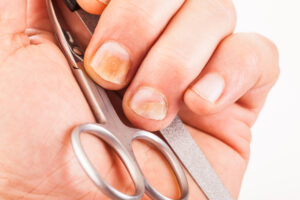Spotlight on Nail Diseases and Treatments
 How healthy are your nails? Nails are made of keratin, just like hair and some skin layers, and they protect the tips of the fingers from trauma. Unfortunately, they’re susceptible to many different diseases and disorders.
How healthy are your nails? Nails are made of keratin, just like hair and some skin layers, and they protect the tips of the fingers from trauma. Unfortunately, they’re susceptible to many different diseases and disorders.
- Nail discoloration: If the nails become discolored, it could be due to smoking tobacco, using dyes, certain medications, infections of or injury to the nail bed, or illness. More than half of cases of nail discoloration are due to fungal infections, which turn the nails yellowish-brown and can be treated with oral or topical medications.
- Bacterial Paronychia: If the proximal or lateral nail folds, which act as a barrier between the nail plate and the surrounding tissue, become broken or torn, bacteria can enter the area. This causes a bacterial paronychia infection, with pain, redness, swelling, and may cause pus buildup under your skin. It’s contagious, but a dermatologist can drain any pus and treat the infection with an antibiotic.
- Ingrown Nails: Nails can grow into the skin at the side of the nail, causing pain and vulnerability to infection. This can occur if the nail curves inward too sharply, if toenails are not cut straight across or fingernails without a gentle curve, from trauma or from wearing tight footwear. A dermatologist can help by lifting the edge of the nail from the surrounding skin or removing the ingrown section.
- Nail Ridges: If your nails develop ridges, it could be the result of a skin condition like eczema or dryness, or one of a variety of metabolic disorders. To treat ridges in your nails, see an experienced dermatologist who can determine and treat the root cause of the problem.
- Thickened Nails: Injuries, fungal infections, and certain illnesses can cause nails to thicken or become ridged, brittle, or discolored. Thick nails can sometimes be thinned, or part or all of the nail may need to be removed. If infection caused the thickening, medication may be prescribed.
- Onycholysis: This condition, the separation of the nail from the nail bed, can be caused by skin disease, infection, or injury. A dermatologist can clip the entirety of the unattached nail and may prescribe medication.
- Skin Cancer Under the Nail: Subungual melanoma is sometimes hard to detect without help from a dermatologist. It can look like bruising but needs to be treated early to prevent the spread of cancer.
If you need help caring for your nails, Swinyer-Woseth Dermatology is committed to providing superior, professional care that’s efficient and compassionate. With over 30 years of experience providing dermatological services in Salt Lake City, we provide a variety of services, from cosmetic skincare to treatment for skin cancer. Our team of board-certified dermatologists and licensed cosmetic service providers, along with our friendly staff, are here to provide you the care you need in a comfortable and professional atmosphere. For more information or to schedule an appointment, contact us through our website or call (801) 682-4715 today.
